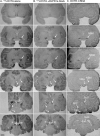The neuroanatomical distribution of oxytocin receptor binding and mRNA in the male rhesus macaque (Macaca mulatta)
- PMID: 24845184
- PMCID: PMC4043226
- DOI: 10.1016/j.psyneuen.2014.03.023
The neuroanatomical distribution of oxytocin receptor binding and mRNA in the male rhesus macaque (Macaca mulatta)
Abstract
The rhesus macaque (Macaca mulatta) is an important primate model for social cognition, and recent studies have begun to explore the impact of oxytocin on social cognition and behavior. Macaques have great potential for elucidating the neural mechanisms by which oxytocin modulates social cognition, which has implications for oxytocin-based pharmacotherapies for psychiatric disorders such as autism and schizophrenia. Previous attempts to localize oxytocin receptors (OXTR) in the rhesus macaque brain have failed due to reduced selectivity of radioligands, which in primates bind to both OXTR and the structurally similar vasopressin 1a receptor (AVPR1A). We have developed a pharmacologically-informed competitive binding autoradiography protocol that selectively reveals OXTR and AVPR1A binding sites in primate brain sections. Using this protocol, we describe the neuroanatomical distribution of OXTR in the macaque. Finally, we use in situ hybridization to localize OXTR mRNA. Our results demonstrate that OXTR expression in the macaque brain is much more restricted than AVPR1A. OXTR is largely limited to the nucleus basalis of Meynert, pedunculopontine tegmental nucleus, the superficial gray layer of the superior colliculus, the trapezoid body, and the ventromedial hypothalamus. These regions are involved in a variety of functions relevant to social cognition, including modulating visual attention, processing auditory and multimodal sensory stimuli, and controlling orienting responses to visual stimuli. These results provide insights into the neural mechanisms by which oxytocin modulates social cognition and behavior in this species, which, like humans, uses vision and audition as the primary modalities for social communication.
Keywords: Autism; Neuroanatomy; Neuropeptide; Nonhuman primate; Oxytocin receptor.
Copyright © 2014 Elsevier Ltd. All rights reserved.
Figures






References
-
- Acher R, Chauvet J, Chauvet MT. Man and the chimaera. Selective versus neutral oxytocin evolution. Adv. Exp. Med. Biol. 1995;395:615–627. - PubMed
-
- Ala Y, Morin D, Mahé E, Cotte N, Mouillac B, Jard S, Barberis C, Tribollet E, Dreifuss JJ, Sawyer WH, Wo NC, Chan WY, Kolodziejczyk AS, Cheng LL, Manning M. Properties of a new radioiodinated antagonist for human vasopressin V2 and V1a receptors. Eur. J. Pharmacol. 1997;331:285–293. - PubMed
Publication types
MeSH terms
Substances
Grants and funding
LinkOut - more resources
Full Text Sources
Other Literature Sources

